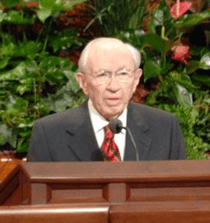Gordon B. Hinckley facts for kids
Quick facts for kids Gordon B. Hinckley |
|
|---|---|
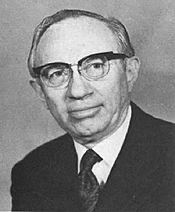 |
|
| 15th President of The Church of Jesus Christ of Latter-day Saints | |
| March 12, 1995 – January 27, 2008 | |
| Predecessor | Howard W. Hunter |
| Successor | Thomas S. Monson |
| President of the Quorum of the Twelve Apostles (with Boyd K. Packer as Acting President) |
|
| June 5, 1994 – March 12, 1995 | |
| Predecessor | Howard W. Hunter |
| Successor | Thomas S. Monson |
| End reason | Became President of the Church |
| First Counselor in the First Presidency | |
| June 5, 1994 – March 3, 1995 | |
| Called by | Howard W. Hunter |
| Successor | Thomas S. Monson |
| End reason | Dissolution of First Presidency on the death of Hunter |
| First Counselor in the First Presidency | |
| November 10, 1985 – June 5, 1994 | |
| Called by | Ezra Taft Benson |
| Predecessor | Marion G. Romney |
| End reason | Dissolution of First Presidency on the death of Benson |
| Second Counselor in the First Presidency | |
| December 2, 1982 – November 5, 1985 | |
| Called by | Spencer W. Kimball |
| Predecessor | Marion G. Romney |
| Successor | Thomas S. Monson |
| End reason | Dissolution of First Presidency on the death of Kimball |
| Counselor in the First Presidency | |
| July 23, 1981 – December 2, 1982 | |
| Called by | Spencer W. Kimball |
| End reason | Called as Second Counselor in the First Presidency |
| Quorum of the Twelve Apostles | |
| October 5, 1961 – July 23, 1981 | |
| Called by | David O. McKay |
| End reason | Called as a Counselor in the First Presidency |
| LDS Church Apostle | |
| October 5, 1961 – January 27, 2008 | |
| Called by | David O. McKay |
| Reason | Hugh B. Brown added to First Presidency |
| Reorganization at end of term |
D. Todd Christofferson ordained |
| Assistant to the Quorum of the Twelve Apostles | |
| April 6, 1958 – October 5, 1961 | |
| Called by | David O. McKay |
| End reason | Called to the Quorum of the Twelve Apostles |
| Personal details | |
| Born | Gordon Bitner Hinckley June 23, 1910 Salt Lake City, Utah, United States |
| Died | January 27, 2008 (aged 97) Salt Lake City, Utah, United States |
| Resting place | Salt Lake City Cemetery 40°46′28″N 111°51′49″W / 40.774497°N 111.86348°W |
| Alma mater | University of Utah (BA) |
| Spouse(s) |
Marjorie Pay
(m. 1937; died 2004) |
| Children | 5; including Virginia |
| Awards | Presidential Medal of Freedom Silver Buffalo Award |
| Website | gordonbhinckley.org |
| Signature | |
Gordon Bitner Hinckley (born June 23, 1910 – died January 27, 2008) was an important American religious leader and author. He served as the 15th President of The Church of Jesus Christ of Latter-day Saints (LDS Church). He led the church from March 1995 until he passed away in January 2008. He was 97 years old.
Church members believed Hinckley was a prophet, seer, and revelator. He was the oldest person to lead the church until Russell M. Nelson became older in 2022. During his time as president, many temples were built. More than half of all existing temples were built under his guidance. He also oversaw the rebuilding of the Nauvoo Illinois Temple. He helped build the huge 21,000-seat Conference Center.
Under his leadership, "The Family: A Proclamation to the World" was shared. The Perpetual Education Fund was also started. When he died, about one-third of the church's members had joined while he was president. He received many awards, including the Presidential Medal of Freedom in 2004. This award was given to him by George W. Bush. He also received the Boy Scouts of America's highest award, the Silver Buffalo. Gordon B. Hinckley passed away from natural causes. His wife, Marjorie Pay, had died in 2004. Thomas S. Monson became the next church president.
Contents
Early Life and Education
Gordon B. Hinckley was born on June 23, 1910, in Salt Lake City, Utah. His parents were Bryant S. Hinckley and Ada Bitner Hinckley. His father was a well-known writer and teacher in the church. Gordon grew up on a farm in East Millcreek. His home had a large library with about 1,000 books. These books covered literature, philosophy, and history.
He finished LDS High School in 1928. Then he went to the University of Utah. He studied English literature and also learned Latin and ancient Greek. He earned his bachelor's degree in 1932. After college, Hinckley became a missionary for the LDS Church. This was not common during the Great Depression. He served his mission in the London-based British Mission from 1933 to 1935. He later wrote the words for an LDS hymn, "My Redeemer Lives."
Starting Church Work
Hinckley came back to the United States in 1935. He had also visited Europe, preaching in Berlin and Paris. His mission president, Joseph F. Merrill, asked him to meet with the church's First Presidency. He was to ask for better materials for missionaries to share the gospel. Because of this meeting, Hinckley got a job as an executive secretary. He worked for the church's Radio, Publicity, and Missionary Literature Committee. He had studied to be a journalist in college, which helped him in this role.
His job was to help with the church's new radio broadcasts. He also used other new communication tools of that time. In the late 1930s, he helped create the church's exhibit for the Golden Gate International Exposition. In 1935, he also taught at a seminary. But he decided to focus on his work with the missionary committee.
After World War II, Hinckley became the executive secretary for the church's Missionary Committee. He also worked with Deseret Book. He was a reporter for the Church News in the late 1940s. In the early 1950s, Hinckley helped find a way to present temple services in many languages. They decided to use a film version of the endowment. His background helped him lead the church when it got more media attention. He learned to use new technology to share the gospel. He also built good relationships with people of other faiths. These experiences helped him throughout his life.
Family Life
On April 29, 1937, Gordon Hinckley married Marjorie Pay. They were married in the Salt Lake Temple. Marjorie was born on November 23, 1911, and passed away on April 6, 2004. They had five children together. Their son, Richard G. Hinckley, became a general authority in the church in 2005. Their daughter, Virginia H. Pearce, was part of the church's Young Women general presidency.
Another daughter, Kathleen Hinckley Barnes Walker, wrote books with Virginia. She also ran an events company. Their son, Clark, has also served in many church leadership roles. He was a stake president and a mission president in Spain. From 2015 to 2018, he was the first temple president of the Tijuana Mexico Temple.
Church Leadership Roles
Local Leadership
After returning home, Hinckley was called to serve as a counselor in the presidency of the East Millcreek Stake. Later, he became the president of that stake. He served there until he was called as an Assistant to the Quorum of the Twelve Apostles. As stake president, Hinckley helped build several church buildings called chapels.
General Authority
In April 1958, Hinckley became a church general authority. He was an Assistant to the Quorum of the Twelve Apostles. This position was later stopped. One of his first tasks was to help dedicate the Hamilton New Zealand Temple that same month. In August 1958, he went to England for the London England Temple open house and dedication. As a general authority, Hinckley kept working with the missionary department.
In early 1960, Hinckley was given the job of overseeing the church's work in Asia. His first trip there lasted two months. He visited Japan, Hong Kong, Taiwan, South Korea, and the Philippines. In the Philippines, he worked to get permission for missionaries to be sent there. He went back to Asia in April 1961. This trip included starting missionary work in the Philippines.
In September 1961, Hinckley became an apostle. He joined the Quorum of the Twelve Apostles. This happened because Hugh B. Brown was added to the First Presidency. After becoming an apostle, Hinckley continued to lead in the missionary department. He also oversaw the church's work in Asia. In February 1962, he traveled to Asia with his wife, Marjorie, for the first time.
In 1964, Hinckley became a board member of KIRO-TV and KIRO-AM/FM. The church had just bought these stations. When the church started Bonneville International Corporation later that year, Hinckley became a vice president. He also served on the board of directors. He traveled around the world with his wife in late 1964. He visited many countries, including Japan, South Korea, Hong Kong, the Philippines, Thailand, and India. He also visited Beirut, Jerusalem, Greece, and Europe.
In July 1965, Hinckley went to Hawaii. He was involved in the first LDS temple services held in Japanese. In the late 1960s, Hinckley helped write official church statements. In the early 1970s, he led the executive committee of the Church Board of Education. In 1972, Hinckley became the first head of the church's public affairs department. He traveled with church president Harold B. Lee and his wife to Europe and Israel.
Serving in the First Presidency
On July 23, 1981, Spencer W. Kimball chose Hinckley to be a counselor in the First Presidency. As the 1980s went on, Hinckley took on more of the daily duties of the First Presidency. This was because other leaders had health challenges. By 1984, Hinckley was the only active member of the First Presidency who appeared in public.
In 1984, the church created Area Presidencies. This meant that church leaders lived in different parts of the world. They could manage church affairs more locally. During his time in President Kimball's presidency, Hinckley dedicated 16 LDS temples. This included the Manila Philippines Temple. When President Kimball died, Hinckley had dedicated almost half of the 36 temples then in operation.
After President Kimball's death in November 1985, Ezra Taft Benson became President of the Church. President Benson named Hinckley as his first counselor. Thomas S. Monson became the second counselor. In the early 1990s, President Benson also had serious health problems. Hinckley and Monson carried out many duties until President Benson died in 1994. During these years, Hinckley dedicated most of the new temples.
After President Benson's death, Howard W. Hunter became president. He kept Hinckley and Monson as his counselors. With President Hunter, Hinckley became the President of the Quorum of the Twelve Apostles. This was due to the church's tradition of seniority.
Becoming Church President
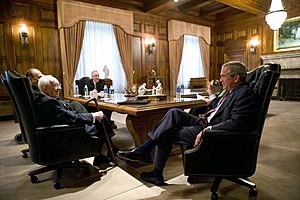
President Hunter passed away after serving for nine months. Hinckley then became the President of the Church on March 12, 1995. He was 84 years old. Hinckley immediately showed a new way of leading. He held a press conference to announce his call. Reporters were invited to ask questions, which was a new approach. On November 2, 2006, Hinckley became the oldest LDS Church president in history. He was older than David O. McKay.
Building Temples and More
Hinckley was known for building temples very quickly. When he became president, there were 47 temples operating. When he died, there were 124 temples. More than two-thirds of these were dedicated or rededicated by him. Another 14 temples were announced or being built. Hinckley also oversaw other big building projects. These included the Conference Center. He also oversaw major updates to the Salt Lake Tabernacle.
Important Messages and Awards
On September 23, 1995, Hinckley shared "The Family: A Proclamation to the World." This was a statement about the importance of family and marriage. It was prepared by the First Presidency and Quorum of the Twelve. In February 1996, there were more church members living outside the United States than inside. In 1996, 60 Minutes interviewed Hinckley. In 1998, he was a guest on CNN's Larry King Live. He remained friends with both Mike Wallace and Larry King until his death.
In November 2000, Hinckley spoke to the youth of the church. He gave them "Six Be's" to live by: Be Grateful, Be Smart, Be Clean, Be True, Be Humble, and Be Prayerful. These ideas were in his book Standing for Something. On March 31, 2001, Hinckley announced the Perpetual Education Fund. This fund helps students in developing countries get loans for education. On October 22, 2002, the Gordon B. Hinckley Building was dedicated at Brigham Young University–Idaho. This was the first building at BYU–Idaho named after a living church president.
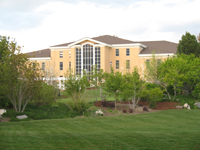
In April 2003, Hinckley spoke about the War in Afghanistan and the Iraq War. He said that citizens should follow their national leaders. He also said that we are a people who love freedom. In March 2005, Hinckley, Thomas S. Monson, and James E. Faust celebrated ten years together in the First Presidency. This was only the second time in church history that a First Presidency had served together for so long without changes.
On June 23, 2004, which was Hinckley's 94th birthday, U.S. President George W. Bush gave him the Presidential Medal of Freedom. This is a very high honor in the United States. The White House said Hinckley "inspired millions" and helped with "humanitarian aid, disaster relief, and education funding across the globe."
Hinckley received many honors from schools. He got the Distinguished Citizen Award from Southern Utah University. He also received 10 honorary doctorates from different universities. He received the Silver Buffalo Award from the Boy Scouts of America. This is their highest honor. In 1996, he received the Golden Plate Award from the American Academy of Achievement.
Later Years and Legacy
On January 24, 2006, Hinckley had surgery to remove some growths. He was also diagnosed with diabetes. In June 2006, he went to Iowa City, Iowa. He spoke at an event celebrating 150 years since the Mormon handcart companies began their journey. On his 96th birthday, June 23, 2006, Hinckley helped break ground for a new building at Brigham Young University (BYU). This building was named the Gordon B. Hinckley Alumni and Visitors Center. It was finished and dedicated on his 97th birthday.
On March 31, 2007, Hinckley rededicated the Salt Lake Tabernacle after it was greatly renovated. One of his last public appearances was on January 4, 2008. He offered a prayer at the rededication of the Utah State Capitol. His very last public appearance was a week before he died. He dedicated the Garden Park Ward building on January 20, 2008.
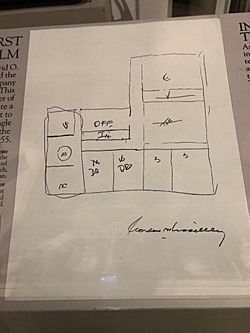
During his time as president, Hinckley gave over 2,000 speeches. He traveled almost a million miles to more than 160 countries. He met with church members and dedicated many meetinghouses and temples.
Gordon B. Hinckley passed away on January 27, 2008. He was 97 years old. He was surrounded by his family in his Salt Lake City apartment. A church spokesman said he died from "causes incident to age." His funeral services were held on February 2, 2008. Tens of thousands of people attended at the Conference Center in Salt Lake City.
Hinckley was buried at the Salt Lake City Cemetery next to his wife. She had died almost four years earlier. Some soil from the Preston England Temple grounds was used for his burial. This was done because he had served as a missionary in that part of England. Thomas S. Monson became the next president of the church on February 3, 2008.
In 2012, a study was published about how Hinckley's voice changed over 50 years. This study helped scientists understand how voices change as people get older. His teachings as an apostle were studied in church classes in 2017.
Images for kids
-
Hinckley receiving the Presidential Medal of Freedom from U.S. President George W. Bush in 2004
See also
 In Spanish: Gordon B. Hinckley para niños
In Spanish: Gordon B. Hinckley para niños



